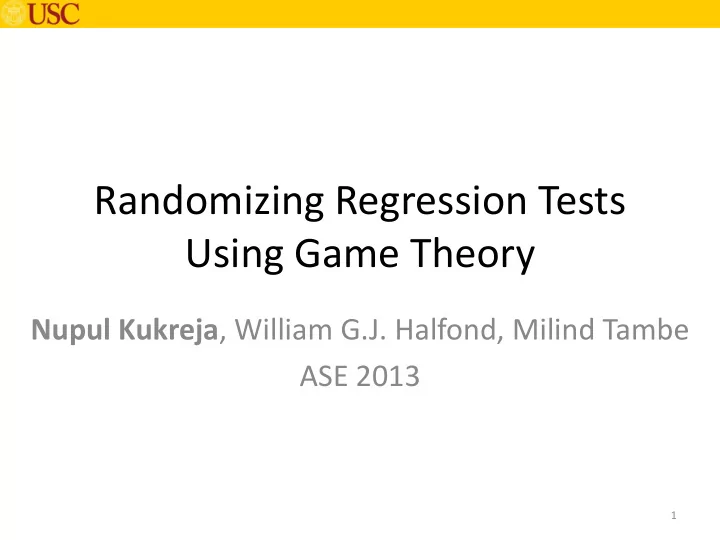

Randomizing Regression Tests Using Game Theory Nupul Kukreja , William G.J. Halfond, Milind Tambe ASE 2013 1
Outline • Motivation • Problem(s) with traditional test scheduling • Game Theory and Randomization • Modeling software testing as a 2-player game • Evaluation • Conclusion & Future Work 2
Motivation Dude! Suite XX is not gonna run! Let’s CODE NOW FIX DEVS LATER The deadline is close too! 3
Motivating Problem(s) • Existing test case scheduling activities are deterministic • Developers know which test cases will be executed when • Developers can check in insufficiently tested code closer to delivery deadline • High-turn around time for fixing bugs in low priority features • Random test-scheduling helpful but treats each test case as equally important 4
Software Testing as a 2-Player Game • This tension between software testers and developers can be modeled as a two-player game • We solve the game to answer the following question: – Given an adaptive adversary (developers) and resource constraints (testers) what is the optimum test-scheduling strategy that maximizes the tester’s expected payoff ? 5
Game Theory • Study of strategic decision making among multiple players – corporations, software agents, testers and developers, regular humans etc., 6
Two- player “Security” Game Adversary Terminal 1 Terminal 2 -3 1 Terminal 1 60% 5 -1 Defender 5 -1 40% Terminal 2 -5 2 Security game assumptions: 1. What is good for one player (+ve payoff) is bad for the other (-ve payoff) 2. Adversary can conduct perfect surveillance and act appropriately i.e., these are simultaneous move games or Stackelberg games 7
Testing Game Developer Requirement 1 Check in ITC* Check in PC* -3 1 Test 5 -1 Tester Requirement 1 5 -1 Don’t Test -5 2 *ITC: Insufficiently tested code *PC: Perfect code i.e., 100% tested 8
Testing Game 0.1398 0.1344 0.2307 0.4538 0.0414 Req 1 Req 2 Req 3 Req 4 Req 5 Tester 2 -10 7 -4 6 -1 9 -9 9 -9 Developer -7 4 -1 3 -6 5 -3 7 -10 3 We solve the game ‘efficiently’ using the ERASER algorithm for solving security games Expected Payoff: Our Approach R1 R2 R3 R4 R5 Tester -8.32 -2.52 0.61 -0.83 -8.26 Developer 2.46 2.46 2.46 2.46 2.46 Expected Payoff: Uniform Random R1 R2 R3 R4 R5 Tester -7.6 -.18 0.4 -5.4 -5.4 Developer 1.8 2.2 2.8 5 0.4 9
Conclusion & Future Work • Mapping of security games to testing games • Can help increase software quality by deterring developers from checking in insufficiently tested code • Future plan: To create a game theory based testing framework and evaluate its effectiveness using open source projects 10
Recommend
More recommend